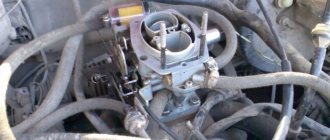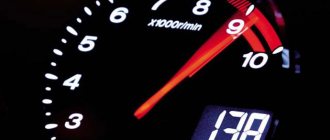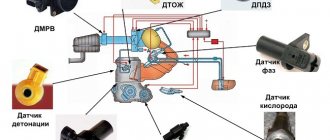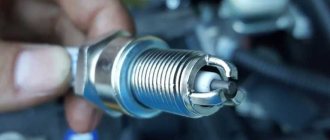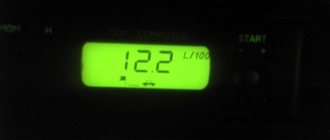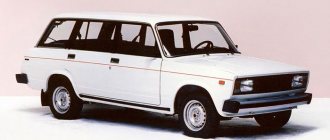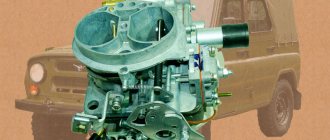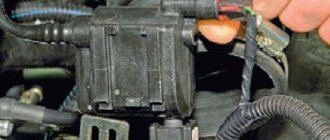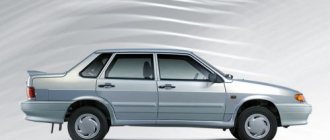The rear-wheel drive sedan VAZ-2106 or the famous “six” first appeared in 1976 and gained enormous popularity among car enthusiasts of the former USSR. The car turned out to be so successful that it was supplied in various modifications for export. In total, more than 4 million copies of this car were produced. Despite the fact that the car was discontinued in 2006, it is still widely seen on the roads. In addition to reliability and high cross-country ability and maintainability, buyers were attracted by the relatively low fuel consumption of all modifications of the VAZ-2106.
Fuel consumption of VAZ 2103, 21033, 21035, 2106, 21061, 21063, 21065-00, 21065-01 cars
Directly adjusting the carburetor should begin with adjusting the float, since the unit directly depends on it. The higher the float is, the more oxygenated the fuel mixture will be. This is good for a certain time, but subsequently the engine's performance decreases, which is why it needs more fuel. To prevent this, you need to adjust the float tongue. You should also set the mechanism so that its stroke is 8 mm. A smaller size will result in loss of power. After this, it is necessary to check the float system assembly, because thanks to it, fuel enters the manifold.
Domestic cars
Someone tell me why this fuel consumption is (20 liters per 100 km). I have a VAZ 21063. Solex carburetor from 2108. The ignition is set. The engine is running normally. Compression is 8-8.5. I take a canister, pour 1 liter of gasoline into it, I put the canister under the hood, put the hose from the filter and the return line in there, it consumes about 20 liters per 100 km. If the “return” is plugged with a bolt (plugged), then fuel consumption is reduced to 12 liters per hundred. Tell me why this happens.
Discussion tags: VAZ 2106 4 doors. sedan (1976 – 2006) dlena I like it! 13305 Comments 11 Add comment modified November 8, 2007 at 12:21
If a Solex is installed on a classic, then the return line must always be blocked. Many people just screw in a screw and that's it. By the way, what Solex? If you anneal it, the consumption is quite normal for this carb. I mean 12 liters.
modified November 8, 2007 at 4:55 pm
I think I have a Solex 21051. the return is connected through a tee in front of the filter. but consumption is within normal limits.
modified November 18, 2007 at 01:52
Regarding consumption, an interesting feature! If you live in Moscow, then I won’t be surprised that the consumption is around 20 if you’re stuck in traffic jams all the time! On my 99 in the summer the consumption was 8-8.5 in the city, taking into account traffic jams! Now it’s at least 12-13. And all because the traffic jams have been hellish since September!
modified November 18, 2007 at 9:52 pm Take Ozone instead of Solex For Subaru Legacy, VAZ 2104 modified February 3, 2008 at 11:48 pm
Similar to fuel consumption on four. The first and second years the machine ate normally (12-13 liters in the city). The third year already 15-16 liters. Now he eats 20 liters around the city. Next year the consumption will probably be more than 20. The engine was checked, the ignition and carburetor were adjusted several times, even the fuel pump was changed and still, it doesn’t go below 20 in the city.
modified on February 6, 2008 at 10:48 am, buy an SUV and you will save on gas! modified February 14, 2008 at 3:23 pm
The engine is running normally. Compression is 8-8.5. I take a canister, pour 1 liter of gasoline into it, put the canister under the hood, put the hose from the filter and the return line in there, it consumes about 20 liters per 100 km. If the “return” is plugged with a bolt (plugged), then fuel consumption is reduced to 12 liters per hundred. Tell me why this happens.
VAZ-2105 owner reviews
With 1.3 engine
- Maxim, St. Petersburg. I have a 1980 six, a good everyday workhorse. Simple and easy to maintain, my dear swallow. Of course, I service it myself, fortunately I still have my father’s garage with the necessary spare parts. The machine does not require qualified repairs; just take a manual. And of course, this requires straight hands, certainly not without it. The six is equipped with a 1.3-liter engine and mechanics that work as smoothly as a clock. The average gasoline consumption per 100 km is 7-8 liters, I fill it with 92.
- Anatoly, Nikolaev. I liked the car, it would be suitable for the role of a first car. I have the 1.3-liter version, with a manual transmission. I bought it together with a trailer - I'm a big business owner. The car consumes 8-9 liters.
- Sergey, Nizhny Novgorod region. The car is awesome, I'm quite happy with it - durable and inexpensive to maintain, I sat down and drove off as they say. Spare parts are inexpensive, I carry them with me in the trunk - a common thing for a pelvis. Consumption 8 liters.
- Yuri, Dnepropetrovsk. I'm happy with the car, a car for all occasions. If you don’t pick too much, then this can be said to be a universal car. At least, together with the VAZ-2106 you can drive on any roads, even on light off-road conditions. The Shahi's suspension is soft and energy-intensive, and is not afraid of breakdowns and potholes. Spacious trunk and interior, clear controls. Everything is so simple that, it would seem, there is nothing to break here. Alas, there are problems, but I attribute them to being 20 years old. The car consumes 8 liters per 100 km.
With 1.5 engine
- Alexander, Lipetsk. VAZ-2106 satisfies all my needs - both in the family and at work. I bought it in 2005, in new condition. I've driven 166 thousand km, everything works stably, with a 1.5-liter engine you can achieve 8-9 liters.
- Yaroslav, Nizhny Novgorod. A good car, a worthy representative of the Soviet automobile industry. But I wouldn’t be upset if it had been taken off the production line during the USSR, and then I definitely wouldn’t have bought it. And so, I have a shah purely for the dacha and various household needs, that’s where it belongs. Consumption 8 l.
- Anton, St. Petersburg. I have a VAZ-2106 with a 1.5-liter unit. Quite a powerful and dynamic car. In addition, what helps the six accelerate quickly is not so much the engine as the lightweight design. I studied the model, consider the body of my shahi to be empty, without any security. Well, that's true, if you're being too picky. But the VAZ will work purely for the city. The car handles well in city traffic and never lags behind. And if anything can be piled up at traffic lights. The 1.6 engine consumes 8-9 liters per 100 km.
- Alexey, Krasnoyarsk. A great car for a beginner, for undemanding guys with straight arms. In principle, any novice driver, even one who does not understand the structure of a car, can handle the six. We buy an instruction manual and go ahead. My car consumes 8 liters.
- Karina, Sochi. I got the six from my grandfather, I drive calmly and leisurely. The VAZ-2106 is a normal car if you use it around the city, don’t drive fast, follow traffic rules and service it on time. I have a 1.5-liter version, it consumes 8-9 liters.
- David, Arkhangelsk. My VAZ-2106 is equipped with a 1.5-liter engine with a preheater. The car is warm and cozy, which is very pleasing. I drive calmly, just to get to work and back home. Average consumption is 7-9 liters.
- Dmitry, Magnitogorsk. The car is awesome, it suits me in almost all respects. Firstly, it is completely adaptable to Russian roads and climate. The engine starts with half a turn even in cold weather, and I also praise the energy-intensive chassis and the precise operation of the gearbox. The steering wheel is empty, although shortcomings in handling are noticeable only at high speeds. But I’m not afraid of this, since I mostly ride around the city. Average consumption is 9 liters per 100 km, I fill with 92nd gasoline.
With 1.6 engine
- Vasily, Irkutsk. Shah pleased me, a solid and unpretentious car, it pleases the eyes of me, my wife and our children. A good family car. There were no problems with installing child seats, everything was fine. Average consumption is 9-10 liters with a 1.6-liter engine.
- Svetlana, Novosibirsk. I like how the VAZ-2106 overcomes our broken roads, as if like a bulldozer. No speed bumps are scary for him. I have a 1.6-liter version, it consumes 9 liters/100 km.
- Andrey, Yaroslavl. The car is fire, I have a 1.6-liter modification. A six with such an engine is a very dynamic vehicle, capable of keeping up even with foreign cars, if, of course, you try hard. In addition, the car has great potential for tuning. I bought the car in 2006, in the last year of its production life. It's called successful. All the same, the car is worth the money, although until recently I doubted this bucket of bolts. A 1.6-liter engine with manual transmission consumes 9-10 liters in the city.
- Konstantin, Moscow region. I like the car, it’s a great option for traveling around the city and to the country. The mechanics and 1.6-liter engine work as they should, they have optimal acceleration dynamics. There is something similar in no other car for that kind of money. The six accelerates and brakes quickly, consumes 10 liters per hundred.
- Nikolay, St. Petersburg. A car for all occasions, equipped with a 1.6-liter gasoline engine, very modern by the standards of that time. But it is not entirely clear why the six were produced until 2006. And they bought it, including me. Oh, how I regretted it, oh, how I regretted it. Breakdowns are a dime a dozen, I no longer have time to go to the service station every time. Still, people are right when they say that it is better to service such cars in your own garage. The car consumes 10 liters per hundred.
- Sergey, Ryazan. I have owned the VAZ-2106 for five years now, and my husband and I drive comfortably. We have a seven with a 1.6-liter engine, a reliable and unpretentious car, with a mileage of 125 thousand km. Consumes 9-10 liters per 100 km.
- Alexey, Bryansk. I liked the six, I serve it myself. By the way, this is my first car. I made it a habit to check my car every morning before leaving. And as a result, no problems on the road. Consumption is 9 liters, under the hood is a 1.6-liter engine.
- Vitaly, Orenburg. A great car for the city, comfortable and soft. If you drive fast, there will be noticeable roll in corners, but this is not critical. In addition, the six is designed for a quiet ride. At least I try not to exceed 70-80 km/h. A VAZ-2106 with a 1.6-liter engine consumes 10 liters. It is possible to fill with 92nd gasoline. I praise the car for its impenetrable suspension. Still, the chassis of the car is very durable, so to speak, for centuries. But the design and reliability of the car leave much to be desired.
With HBO (on gas)
- Andrey, Vologda region. I'm happy with the car, the car suits me in all respects. I have a gas version based on a 1.6-liter engine. The dynamics have disappeared a little, but this is not significant compared to the advantages that the ability to drive on gas brings. Consumption has remained almost unchanged and is 9-10 liters, but costs have been reduced by almost half. The car is used as a taxi.
- Dmitry, Tver region. The car is worth the money, I have a 1.6-liter version with gas equipment. Consumes 11 liters, and I think this is acceptable for this class, taking into account the age of the car.
- Oleg, Kaliningrad. My gas VAZ-2106 has covered 98 thousand miles. Everything seems to be fine, but the smell of gas in the cabin is annoying, especially when I press it to the floor. You have to open the windows, otherwise you might suffocate, no problem. Average consumption is 8-9 liters.
- Nina, Krasnodar region. This is my favorite car, an indispensable assistant in household matters. The gas 1.6-liter engine allows you to save money on the operation of the six. In the city the car consumes 8-10 liters.
- Oleg, Perm region. VAZ-2106 is a very unpretentious and durable city car, I bought it for working as a taxi. The car is from 2006 and I still drive it. Despite the mileage of 180 thousand km, I am satisfied with the car. It is easy to maintain, and many breakdowns can be solved even in the middle of the road, as long as you have the necessary set of tools at hand. I have a 1.5 liter version with gas. In the city you can keep within 10 liters, on the highway it turns out to be 7-8 liters per 100 km.
VAZ 2106 fuel consumption carburetor 1.3, 1.6 – Similar news
| VAZ 2106 1. 3, 1. 5, 1. 6 carburetor real reviews of fuel consumption - b If fuel consumption is much higher than the average values given in the tables, the car must be taken to a service station with mechanics and, after determining all the factors of increased consumption, it is possible , it’s worth switching it to gas. You can try to bring the burnt rings back into working condition by filling the cylinders with a mixture of 50 acetone, 25 kerosene, 25 motor oil, 10 cubes each, crank the crankshaft several times and leave it standing for 7-8 hours. |
Loading of the vehicle and operation with a trailer • All damaged wiring should be replaced; checking it is not difficult; just start the engine in the dark and open the hood.
Sensors and electronics that affect flow. Fuel consumption VAZ 2106
| Huge fuel consumption for 2106 / VAZ (classic): forum of car enthusiasts, exchange of experience, expert opinions - automobile forum Here we note that it will not be possible to reduce consumption below certain indicators, since the engine will not run on air, but minimizing consumption as much as possible is quite realistic . The increased flow rate is influenced by the coolant temperature, throttle position, mass air flow and detonation sensors. |
Engine 1.5 • To make the six more economical, it was necessary to install a more modern Solex carburetor model DAAZ 2108 and a five-speed gearbox.
Main factors influencing increased fuel consumption
VAZ 2106 is a domestic car, which is known for its durability and stability. Fortunately, all domestic cars have one big advantage - the fuel consumption of the VAZ 2106 is not high, which makes such a purchase even more successful. Of course, fuel consumption standards for the Lada 2106 in the city significantly exceed fuel consumption on the highway. The reason for this is that in the city the car is not at a stable speed, it stops, slows down, etc., such work consumes more energy.
Is it possible to develop individual standards?
Finally, we note that consumption is affected not only by the technical condition and operating features. Savings also largely depend on the fuel itself. If it is of poor quality and contains impurities, then much more of it will be consumed (it will not be able to burn fully, hence the drop in power and the need to press the gas pedal more to obtain the necessary driving dynamics). Therefore, refueling with high-quality fuel, even if it is a little more expensive, ultimately results in savings.
VAZ 21011
“Zero Eleven” or “Zhiguli-1300” is a modified model of the base VAZ 2101. The changes affected only the appearance (the radiator grille received more vertical bars, “fangs” disappeared from the bumpers and rubber pads appeared, brake lights received reflectors). The VAZ 21011 was equipped exclusively with a 1.3-liter engine with a power rating of 69 hp.
| Engine | Consumption (city) | Consumption (highway) | Flow (mixed) | Type of fuel |
| 1.3 MT 69 hp | 9.4 | 6.8 | 8.0 | Petrol |
Engine faulty Ignition system
The fuel consumption for each specific car with a particular engine, installed by the manufacturer, can be found in any operation or repair manual or on our website in the article Fuel consumption of a VAZ car with carburetor engines. The reason for this is that in the city the car is not at a stable speed, it stops, slows down, etc., such work consumes more energy.
| Engine | Consumption (city) | Consumption (highway) | Flow (mixed) | Type of fuel |
| 1.5 MT 72 hp | 9.0 | 7.5 | 8.2 | Petrol |
| 1.5 MT 79 hp | 10 | 5.7 | 7.2 | |
| 1.5 MT 92 hp | 8.8 | 5.6 | 7.6 | |
| 1.5 MT 94 hp | 9.0 | 7.5 | 8.2 | |
| 1.6 MT 81 hp | 9.0 | 5.6 | 7.5 | |
| 1.6 MT 89 hp | 9.0 | 7.5 | 8.2 | |
| 1.6 MT 90 hp | 10.0 | 5.8 | 7.3 | |
| 1.7 MT 90 hp 4x4 | 11.8 | 9.5 | 10.2 | |
| 1.8 MT 98 hp 4x4 | 11.8 | 9.5 | 10.2 |
Video: how to save gasoline in simple ways
Let’s assume that all Zhiguli owners agree that during that period of time we didn’t think about how to save fuel since it cost three kopecks, and everyone could afford at least a hundred liters a month. The tank is equipped with a neck for filling gasoline; it is brought out through the hatch of the rear right wing and sealed to prevent the penetration of dust and dirt particles into the tank.
Engines and official fuel consumption rates of the VAZ-2106. Ignition system
| Consumption for a VAZ 2106 according to the passport The changes affected only the appearance: the radiator grille received more vertical bars, fangs disappeared from the bumpers and rubber pads appeared, brake lights received reflectors. Music lovers will have to choose between music and gas mileage, especially for those who use significant audio equipment such as a subwoofer or a large number of speakers. |
| Fuel consumption of VAZ 2106 Lada (1.6 l). An overflow in the carburetor due to a leaky shut-off needle valve or an incorrectly adjusted fuel level will also waste some fuel. I was also completely satisfied with the fuel consumption in the city, no more than ten liters, and on the highway during normal driving it was possible to keep within 7.5-8 liters. |
Reasons for increased fuel consumption not related to the carburetor • The engine of this car is the result of modifications to the penny engine to increase power.
What is the fuel consumption of the Lada and how to reduce it
If you have already decided to buy this car, but are not informed about possible or frequent breakdowns of this model, its weak points and the real fuel consumption of the VAZ 21063 - then experienced motorists, former owners of a VAZ of this model or just experienced auto mechanics.
Only after consulting with them, you will be able to make the right decision, or, perhaps, you will be insured against unpleasant situations and possible breakdowns. Now about the ignition system, since it also affects consumption. Heavily clogged spark plugs that have almost exhausted their service life and work intermittently, incorrectly installed ignition on the engine, losses due to breakdowns of high-voltage wires and tips - all this can have a significant impact on consumption.
Practical recommendations
Fuel consumption is affected by:
- technical condition of the machine;
- operating features.
In order to achieve more economical consumption, it is necessary to promptly clean and replace certain components of the mechanism.
In particular, an increase in the amount of gasoline or gas consumed is often a sign that the engine has almost exhausted its resource.
Wear of the cylinder-piston increases the gaps between the cylinder walls and the rings. Because of this, exhaust gases and the fuel-air mixture enter the piston space. For the same reason, compression in the cylinders drops. The warm air mixture cannot burn completely. Therefore, part of the mixture remains unused and simply flies out through the exhaust pipe. Engine wear affects its functioning. Because of this, the car accelerates poorly. The driver has to press the pedal harder to accelerate the car. Taking all this into account, it is not difficult to conclude that in order to reduce gasoline or gas consumption, you must first diagnose the engine. You need to measure the compression, listen to whether the engine makes any unusual noises during operation. If worn components are found, they must be replaced.
Also, the consumption of gasoline or gas depends on the condition of the gas distribution mechanism. If carbon deposits that form on valve seats and edges are not promptly removed, this will lead to loss of compression due to a loose fit.
Cleaning the valves and, if necessary, repairing the cylinder head will significantly reduce gasoline/gas costs. It is important to promptly diagnose the gas distribution mechanism and promptly replace worn parts.
Fuel consumption also depends on the carburetor. If you install a contactless ignition system and a Solex carburetor, then this combination will reduce the amount of gasoline or gas consumed. It is very important to adjust the carburetor correctly. It will be possible to reduce consumption by installing jets with a reduced cross-section. However, this will lead to a decrease in the dynamics and power of the machine. After this adjustment you will have to forget about overtaking. It will be very difficult to accelerate such a car. Therefore, it is better to carry out adjustments without replacing the jets. It is necessary to adjust the carburetor in such a way as to achieve a “golden mean” between power and fuel consumption. If the carburetor is clogged and incorrectly adjusted, fuel dosing is disrupted. Therefore, regularly check the condition of the carburetor and wash it periodically.
Insufficient tire pressure. Fuel consumption VAZ 2106
| What affects the fuel consumption of the VAZ 2109 In more detail, setting the ignition timing on front-wheel drive models of VAZ cars is described on the page Setting the ignition timing on carburetor engines 2108, 21081, 21083. Here we note that below certain indicators it will not be possible to reduce consumption, since the engine cannot operate in air there will be, but minimizing consumption as much as possible is quite realistic. |
- condition of the cylinder-piston group - when worn, consumption increases by 20-25%,
- coolant temperature – when it decreases relative to the optimum, the overconsumption increases by 8-10%,
- high oil density, especially in winter, when friction in the engine and transmission increases losses,
- clutch slipping,
- a jammed brake caliper and an unadjusted brake system as a whole,
- underinflated tires (a more economical option - slightly overinflated by 0.2 atm.),
- over-tightened wheel hub bearings add another 10-15% to the consumed volume of fuel.
Specifications... Specifications
| VAZ 2106 how to reduce fuel consumption - auto magazine Acord-auto The compressor is pressed to the spark plug hole, and an assistant, fully depressing the gas pedal, turns the engine with the starter, 3-4 seconds is enough to get results. Paired with a balanced five-speed manual transmission, it accelerated the car to 155 kilometers per hour, and the dynamic acceleration to hundreds became 16 seconds. |
- Technical condition of the car;
- Features of operation;
What affects consumption? • Check tire pressure regularly.
